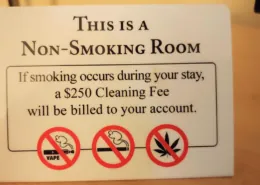The Hidden Dangers of High Lead and Nickel in Illegal Vape Devices
As vaping gains popularity, particularly among teenagers, a recent scientific study conducted at Baxter College, Kidderminster raises alarming questions about the safety of this activity. They discovered that the vapes being used by students contained dangerous levels of lead and nickel—more than twice the daily safe amount of lead and nine times that of nickel.
The Inter Scientific laboratory in Liverpool, renowned for their collaboration with vape manufacturers to uphold regulatory standards, embarked on an investigative journey into the world of vapes. They examined a total of 18 vapes, mainly illegal and devoid of any regulatory checks before they infiltrated the UK market.
Lead, Nickel, Chromium
The laboratory was appalled by the results. Co-founder David Lawson lamented the findings, calling them the “worst set of results” he’d ever seen in his 15 years of testing. Certain vapes—artfully disguised as brightly colored highlighter pens—contained:
- Lead: 12 micrograms per gram, 2.4 times the stipulated safe exposure level
- Nickel: 9.6 times safe levels
- Chromium: 6.6 times safe levels
It’s logical to assume the metals stemmed from the heating element, but surprise, surprise! Tests revealed that they were, in fact, present in the e-liquid itself.
In addition to the harmful metals, the lab tests unveiled carbonyls—compounds that break down into formaldehyde and acetaldehyde, both found in cigarette smoke. These were found at 10 times the level in legal vapes, with some vapes even surpassing cigarette levels.
Although manufacturers are required to follow regulations on ingredients, packaging, and marketing, and register all e-cigarettes and e-liquids with the Medicine and Health Care Products Regulatory Agency (MHRA), the agency doesn’t have the authority to verify claims or investigate unregistered products.
The Reaction
The reaction at Baxter College, where the vapes were initially confiscated, was one of horror. Students Leon and Oscar, who had their vapes seized, confessed they were hooked on nicotine and found quitting vaping challenging.
Ignoring The Risks
The boys admitted it was easy to overlook the dangers, with Oscar saying, “You won’t really care, if you’re addicted to it – you’ll just forget about it.” Leon, on the other hand, believes that regulation and policing should be stepping up their game.
The School’s Approach
Mat Carpenter, the Head teacher, was appalled by the findings and has since installed sensors in school toilets to curb vaping opportunities. He also insists that society needs to convey a dual message—vaping can be beneficial for those trying to quit smoking, but it’s not suitable for children.
The Scientific Standpoint
John Britton, an epidemiology professor at the University of Nottingham, emphasized that inhaling metals is dangerous. Lead impairs brain development, chrome and nickel are allergens, and metal particles in the bloodstream can trigger blood clotting and exacerbate cardiovascular disease. Furthermore, the carbonyls, though mildly carcinogenic, can increase cancer risk over time.
Illegal vapes are on the rise, and distinguishing between the legal and illegal is becoming increasingly difficult. The government has earmarked £3m to curb the sale of these vapes, calling for evidence to help limit children’s access to these products. However, despite it being illegal to sell vapes to under-18s, there’s been an increase in experimental vaping among 11- to 17-year-olds.
A Call to Arms
As the vaping crisis intensifies, it’s vital to reinforce the regulatory framework and vigilance. Parents, educators, and society as a whole must unite in sending a clear message—vaping isn’t child’s play. Only a combined effort will help protect our children’s future and pave the way for a healthier society.
Report source: Vaping: High lead and nickel found in illegal vapes
Frequently Asked Questions
What are the potential dangers of vaping?
Vaping, especially with illegal products, can expose users to harmful substances such as lead, nickel, chromium, and carbonyls which can have detrimental health effects.
What has been done to regulate the sale of vapes?
The government has allocated £3m to tackle the sale of illegal vapes in England, aiming to fund more test purchases and have the products removed from shops.
How can schools discourage vaping?
Schools like Baxter College have installed sensors in school toilets to reduce vaping opportunities and initiated conversations to educate students about the dangers of vaping.
Are all vapes harmful?
Not all vapes are created equal. Legal products typically have far lower levels of harmful substances compared to illegal ones. However, all vapes do contain some level of harmful substances.
Are teenagers aware of the dangers of vaping?
While some may be aware, the risk is often overlooked due to addiction and lack of enforcement of regulations around vape sales to under-18s.
- Is Vaping and Driving Illegal in Vermont? (2025 Guide) - July 18, 2025
- Vaping Laws in Vermont : A Comprehensive Guide for 2025 - July 18, 2025
- Malaysian Sarawak Considers Banning Vape Product Sales - July 18, 2025









